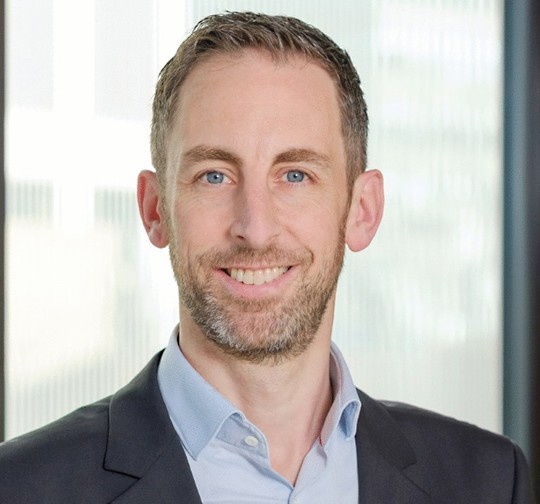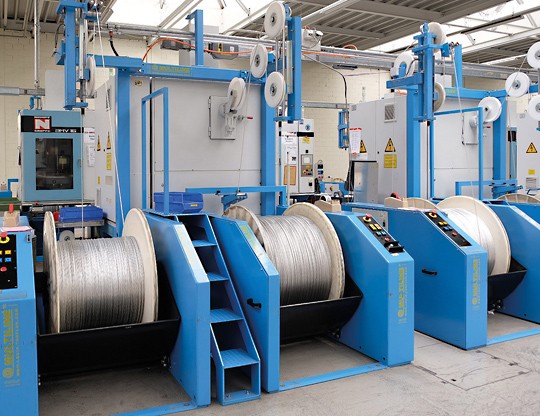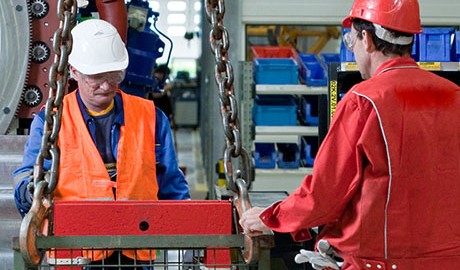Digital transformation
Where innovation is rooted in tradition
Digitalisation is forcing many long-standing Swiss companies to make extensive changes in order to survive – and the manufacturing industry is no exception. Dätwyler Cabling Solutions, based in the Swiss canton of Uri, shows how to marry tradition with innovation.
Text: Hansjörg Honegger, Image: Dätwyler Cabling Solutions
Innovative companies make money – with new or improved products, integrated solutions and services. Many statistics show Switzerland to be the world leader in innovation, but the trend is actually headed in a different direction. In 2016, 54.6% of Swiss industrial companies stated that they were introducing product or process innovations. In 2014, Swiss manufacturing companies were still the world leaders at 60.2%. This is one of the findings of the study “Research and Innovation in Switzerland 2020” published by the State Secretariat for Education, Research and Innovation (SFBI).
The causes are complex, as the study also shows. Interaction between educational institutions, government and the economy, as well as opportunities for the transfer of knowledge and technology, are just as important as the internal organisation of companies and their culture of innovation.
Rooted in the community
Truly embracing innovation means more than simply planning for it or mentioning it in a glossy company brochure. It requires a corporate culture that is open to new ideas and is ready to face challenges and adapt accordingly. Founded in 1915 and based in the Swiss canton of Uri, Dätwyler Cabling Solutions is a traditional company whose history perfectly exemplifies this premise. Together with its sister company, Dätwyler Holding AG, the company is the canton’s largest employer and is deeply rooted in the population. “We have employees whose parents and grandparents worked for Dätwyler,” says Adrian Bolliger, Managing Director Europe at Dätwyler Cabling Solutions.

Adrian Bolliger, Managing Director Europe at Dätwyler Cabling Solutions
“It requires everyone in the company to be ready and willing to make the change.”
Adrian Bolliger, Managing Director Europe at Dätwyler Cabling Solutions
But this long-standing company operates in a very competitive field, having made a name for itself internationally in the cabling systems market. “In this segment, however, a lot of things are now defined mainly by price,” says Bolliger. This is tough for a company based in the high-wage country of Switzerland, which prides itself above all on quality, service and innovation. The business model had to change, but without alienating the company’s loyal, long-serving and highly trained employees.
Switzerland is falling behind
According to the SFBI study, there are two ways to make money from innovations: either develop an innovative product that is new to the company and comparable in function to other existing products (company innovation), or introduce something completely new (market innovation). For industrial companies in Switzerland, company innovations represent around 15% of sales, market innovations around 7%. Switzerland is falling behind other countries when it comes to market innovations; in the Netherlands this figure is 16.5%, with 12.6% in Italy and 11.5% in France.
Adrian Bolliger is aware of this issue. “We are well-versed in developing and optimising our products and solutions.” But that is no longer enough today. Sometimes business models have to be completely redesigned. For Dätwyler Cabling Solutions, this means evolving from cable manufacturer to IT solution provider. “More and more customers are looking for a comprehensive consultation when it comes to IT infrastructure, rather than an isolated approach that focuses only on cabling. And this is precisely where we fit in – by offering our customers sustainable IT infrastructures that adapt to their needs.” This also involves investment and investment protection. The amount of data is growing rapidly, but cloud-based solutions are not the only option. In fact, there is a pronounced trend for processing more data on site. “We identified this trend years ago, and made it one of our new core competencies – flexible and fast solutions that optimise the flow of data in terms of security, speed and benefits,” explains Bolliger. By offering a range of services including consulting, implementation, maintenance and servicing, Dätwyler Cabling Solutions has transformed itself into a service provider.
Learning within your own company
The way products and services are developed is also changing. For example, in order to learn more about IoT and develop services for the market, Dätwyler Cabling Solutions networks its own machines, imports the data into its own mini data centres and has begun using this data to optimise production processes. “We are working with Swisscom and our own IT department to develop an optimal solution,” says Bolliger. Dätwyler is consciously setting out on the long, bumpy road toward product development transformation. This allows the company to learn for itself how best to do it – knowledge it can then pass on to its customers. “This is opening up exciting prospects for tackling the market together with Swisscom.”

Dätwyler Cabling Solutions aims to evolve from a cable manufacturer to a service provider.
Becoming a company that can maintain its global reputation as a producer of cable systems while also offering its customers and partners more far-reaching solutions – it’s a long path and one that requires meticulous planning. After all, a company that actively cultivates and promotes innovation will be more successful than one that sits and waits for the brilliant idea to come from someone else – another finding of the SFBI study.
Management has drawn up a plan to be implemented within four years (see “The six workstreams”). “We work in six workstreams, each of which is led by a member of the management team,” says Bolliger. “By 2022, the company will be reorganised and realigned. We call our transformation project ‘WeMove’.”
Involving employees is a must
Restructuring on this scale naturally also involves changes for the employees. And again, we can look to traditional company Dätwyler here. Bolliger nods earnestly when asked about this topic. “It requires everyone to be ready and willing to make the change, because we are working in partnership with our employees. We explain to them exactly why this is necessary, what we are changing for what reason and what skills are needed to do so. Most employees understand that and are willing to take the journey with us.” Adrian Bolliger is also willing to give his employees the time they need. For example, the department head whose team was selected for the Lean Management project. “He suddenly had an entirely different job. I gave him a book to read with lots of background information, and we discussed the requirements together. After a while he came to me and said: I’ll do it!”
The 105-year-old company is setting out on the journey of modernisation with its employees, just as it did in the 80s when the company began producing fibre optic cables – which was an unprecedented innovation at the time. But one thing is clear to Bolliger: “Manufacturing is in our DNA, and we will never be a pure service provider.” That is probably a good thing, since Dätwyler Cabling Solutions is certainly already one of the 54.6% of Swiss companies that are innovating.
The six workstreams for change
Dätwyler Cabling Solutions has adopted a systematic process for reinventing itself. The transformation will be completed within four years and in six workstreams.
1. Structures
Builds the future organisation that meets the requirements of an IT company. Lean and agile organisational structures help ensure success in the rapid development of new services and products. For example, the company introduced a business development function alongside product management to increase its focus on radical innovation.
2. Processes
All processes and tools are revised and, where necessary and appropriate, digitalised or automated for efficient, powerful operations. This includes the use of RPA (robotic process automation) for inside sales.
3. Internal Communication
This workstream involves reworking communication with and between employees. The company uses various channels to share relevant messages with employees in production and sales in different countries, for example.
4. External Communication (marketing)
Not only is Dätwyler Cabling Solutions’ brand first-class, it is also clearly positioned. A number of adjustments are required to truly raise Dätwyler’s profile as an IT company. For example, the company is making greater use of social media for external communication, but the brand will also be changed to Dätwyler IT Infra in the coming weeks. This approach combines the best of both worlds: Dätwyler as a strong brand with a reputation as an IT provider.
5. Innovation
This workstream defines innovations – both evolutionary and revolutionary – for cabling systems and for the IT business. The two come together in use cases for complete solutions. The method of development, for example waterfall model and/or scrum, is defined in workstream structures.
6. Skills
This workstream combines the best of both worlds: the employees – some of whom have been making a name for themselves in the cabling systems field for decades – and the new skills required in the field of IT. Dätwyler Cabling Solutions is able to achieve this thanks to an intelligent mix of employee training and specialist recruitment.

Newsletter
Would you like to regularly receive interesting articles and whitepapers on current ICT topics?
More on the topic:



